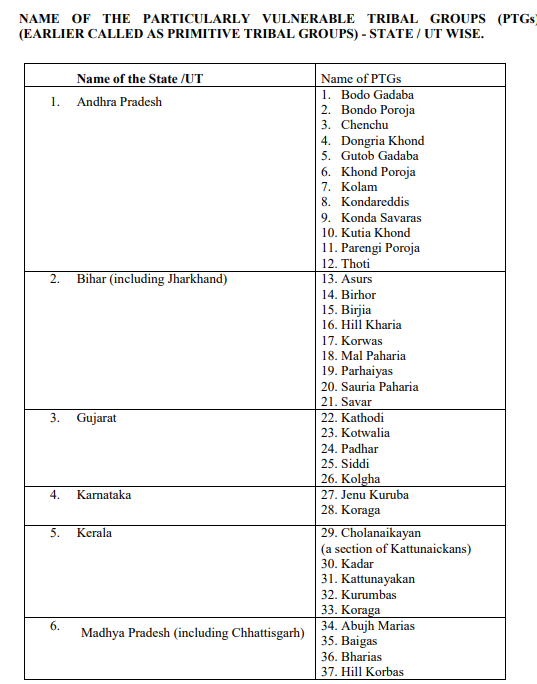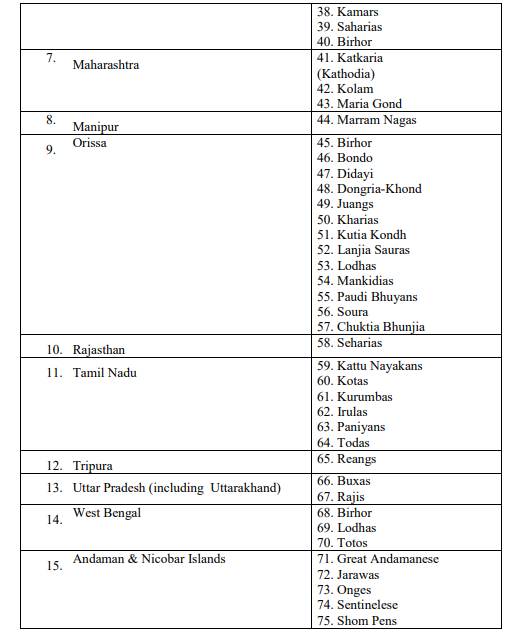PVTG Particularly Vulnerable Tribal Groups, are more vulnerable among the tribal groups. Due to the fact that more evolved and assertive tribal groups in India consume a significant portion of the funds allocated for tribal development, PVTGS require greater funding specifically for their growth. 8.6% of the population in India is made up of tribal people.
The majority of PVTGs are homogenous, have a tiny population, are physically remote, lack written language, have relatively simple technology, and change occurs at a slower rate.
The Dhebar Commission established Primitive Tribal Groups (PTGs) in 1973 as a distinct category of tribal groups that are less advanced. In 2006, the Indian government renamed the PTGs to PVTGS.
PVTGS in India [Latest News]
The Pradhan Mantri PVTG Development Mission would be established in order to ameliorate the socioeconomic circumstances of the especially vulnerable tribal groups (PVTGs), according to the Finance Minister’s statement in the Union Budget 2023-24.
The Finance Minister also announced that, as part of the Development Action Plan for the Scheduled Tribes, Rs. 15,000 crores would be made available over the course of the following three years to carry out the Mission.
History of Particularly Vulnerable Tribal Groups
Primitive Tribal Groups (PTGs), the least advanced of the tribal tribes, were established as a separate category by the Dhebar Commission in 1973. In 2006, the Indian government changed the PTGs’ name to PVTGS (Particularly Vulnerable Tribal Groups).
Against this backdrop, the Government of India started to designate the most vulnerable tribal tribes as a new category called PVTGs and proclaimed 52 such groups. In 1993, another 23 groups were added to the category, bringing the total number of PVTGS to 75, out of 705 Scheduled Tribes.
The majority of the 75 listed PVTGS are found in Odisha, followed by Andhra Pradesh.
PVTG Full Form
PVTG stands for Particularly Vulnerable Tribal Groups. The PVTG, as a distinct category, was born out of the observation of the Dhebar Commission in 1973. PVTG are identified as the most vulnerable inhabitants residing in the less developed regions of India.
- They reside in different topographies such as hills, plains, forests, or any remote area.
- According to the estimates and information provided by the census, there are 12 PVTGs that have a population of more than 50,000 and the other groups of PVTG have a population of 1000 or less than it
- Saharityas are a group among the PVTGS that represents the highest population whereas Sentinelets and Andamanese are very less populated.
Distribution of PVTGS in India
The PVTGs have been majorly identified in 18 states and the union territory of the Andaman & Nicobar Islands. They are largely distributed in different parts of India as per the 2011 census data.
- States and Union Territories in India
- Government Schemes


PVTG Criteria for Livelihoods
The livelihood options for Particularly Vulnerable Tribal Groups cover a wide range that entails food gathering, collection of non-timber forest produce, hunting, shifting cultivation, livestock farming, and artisan works. The non-timber forest produce includes products like honey, gum, amla, bamboo, shrubs, fuelwood, dry leaves, nuts, sprouts, wax, medicinal plants, roots, and tubers.
- The major objective behind the collection of forest products is consumption.
- The extra amount of products that are left after consumption is sold to the middlemen. The PVTGS are victims of exploitation by the middlemen.
- The prominent changes in the environment that have a huge impact on the forests accompanied by the legislation regarding the conservation of forests are serious challenges to the interests of the PVTGs.
Health Issues in Particularly Vulnerable Tribal Groups
There exist improper conditions of health among the PVTGs which are backed by reasons such as extreme poverty, lack of access to healthcare facilities, low literacy rates, economic backwardness, unsafe drinking water, malnutrition, poor sanitation, and so on.
The diseases that are commonly found among PVTGs are:
- Anaemia
- Respiratory diseases
- Malaria
- Gastro-intestinal infections
- Skin infections
Government Schemes for PVTGS
As a developmental intervention by the government, the Ministry of Tribal Affairs administers the “Development of Especially Vulnerable Tribal Groups (PVTGs)” Scheme, only for PVTG Tribes. It intends to provide comprehensive support for the socio-economic betterment of primitive tribal groups.
- Under this PVTG scheme, facilities are provided in the areas of housing, distribution of land, construction of roads, agricultural development, facilities for livestock rearing, provisions of energy security, and social security.
- Financial assistance is extended to protect the interests of these tribal groups and facilitate their survival.
- A development plan for the time span of five years is prepared under the scheme which is referred to as the Conservation-cum- Development (CCD) plan.
- An expert committee appointed by the Ministry of Tribal Affairs approves the CCD plan.
- The CCD plan identifies a particular territory of the PVTGs and prepares a financial plan to implement the welfare programs.
- The progress made by the scheme is assessed by the concerned Ministry and NITI Aayog.
Additionally, PVTGs are given preference under the Special Central Assistance (SCA) to Tribal Sub-Scheme (TSS), Grants under Article 275(1) of the Indian Constitution, Grants-in-Aid to Voluntary Organizations working for the Welfare of Schedule Tribes, and Strengthening of Education among ST Girls in Low Literacy Districts schemes.
Reproductive Rights of PVTGs
It was reported that the PVTGs were not allowed to use contraceptives till 2018 due to their declining and stagnant population. A Public Interest Litigation was filed in the High Court of Chhattisgarh, which questioned the actions of the government in depriving the tribal groups of their reproductive rights.
This was particularly concerned with the Baigas of Chhattisgarh. The High Court ruled that there is a violation of the Right to Privacy under Article 21 of the Constitution. As a result, the tribal group has conferred the right to use contraceptives.


